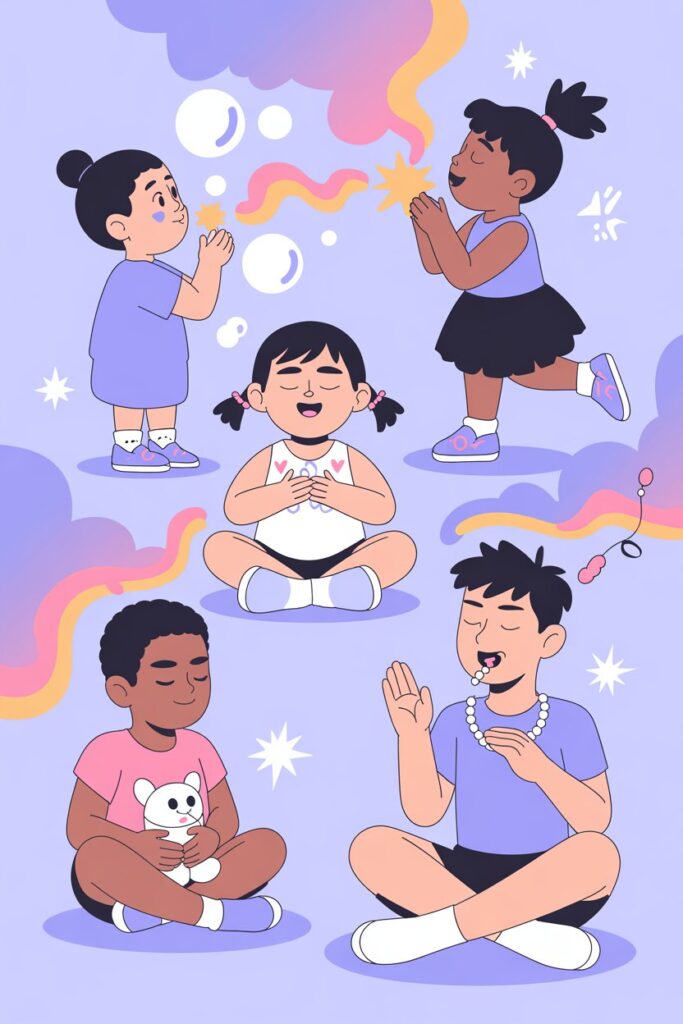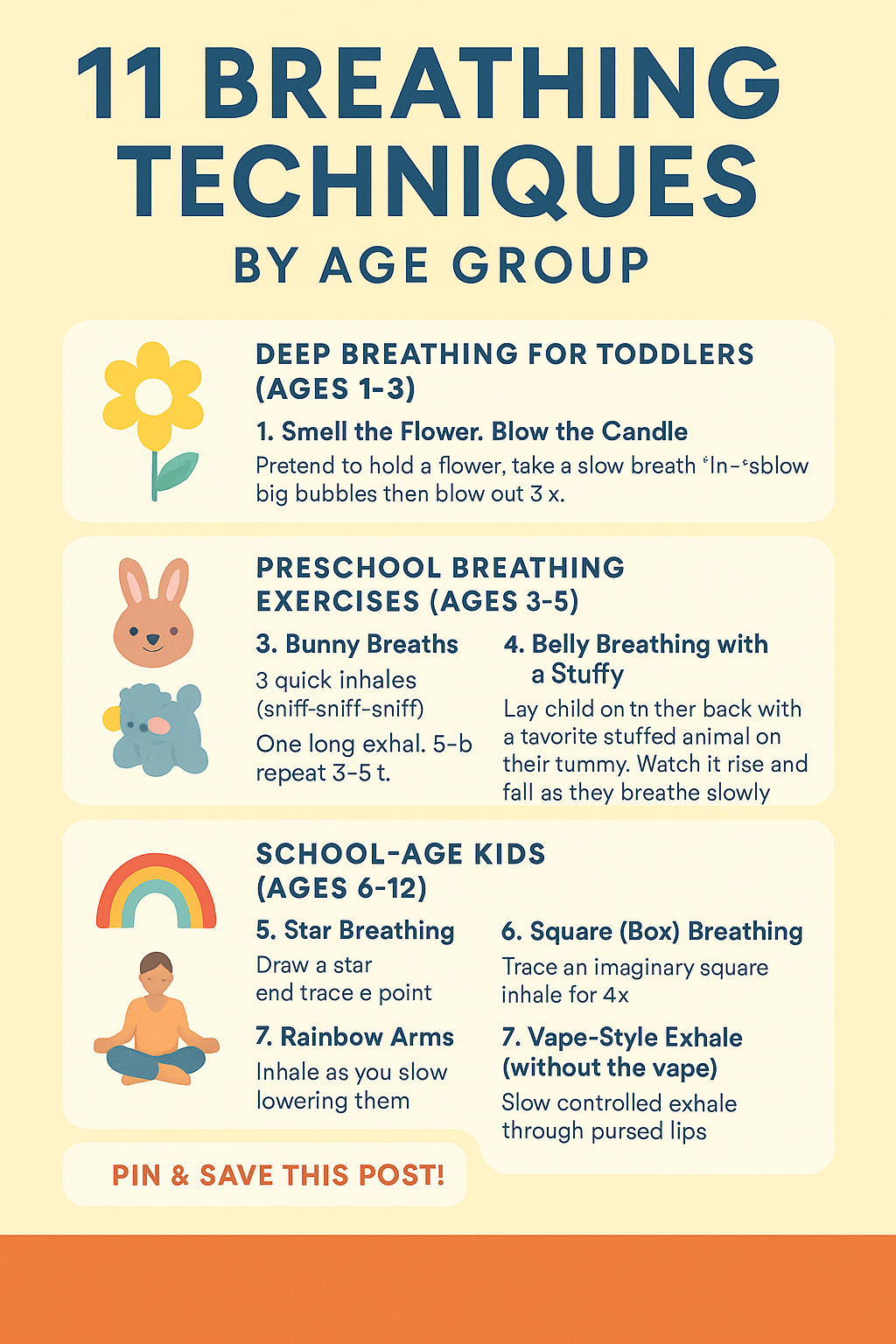🧘 11 Brilliant Deep Breathing Exercises for Kids (By Age Group)
Deep breathing exercises for kids are powerful tools for emotional regulation. If your child struggles with big feelings—whether it’s tantrums, bedtime anxiety, or test-day jitters—simple techniques can make all the difference.
In this guide, you’ll find age-specific deep breathing techniques for kids, from toddlers all the way to teens. Whether you’re looking for a fun breathing game, a printable visual aid, or tools to make practice easier, this post has you covered.
Grab your free printable chart at the bottom—and don’t forget to pin this post for later!
Heads up: This post may include affiliate links. As an Amazon Associate, I earn from qualifying purchases—at no extra cost to you. Full privacy policy and disclosure here.

🌼 Deep Breathing exercises for kids (Ages 1–3)
Toddlers are just beginning to explore their emotions—and their attention spans are short. Stick to visual, playful methods.
1. Smell the Flower, Blow the Candle
Pretend to hold a flower: take a slow breath in (smell the flower), then blow out a pretend candle. Repeat 3x.
Great for modeling during meltdowns!
💡 Tip: Hold real objects like a silk flower or LED candle for added fun.
2. Bubble Breaths
Use a bubble wand (like this one) and encourage slow, steady exhales to blow big bubbles. Teaches breath control in a tangible way.
🐰 Deep Breathing exercises for kids (Ages 3–5)
These deep breathing exercises for kids are not just calming—they’re also fun and developmentally appropriate.
At this age, kids love to imagine and copy what they see.
3. Bunny Breaths
Three quick inhales (sniff-sniff-sniff), then one long exhale. Do 3–5 rounds together.
4. Belly Breathing with a Stuffy
Lay your child on their back with a favorite stuffed animal on their tummy. Watch it rise and fall as they breathe slowly.
🧸 Bonus: Try this with a weighted animal like the Hugimals therapeutic plush to combine breathing with grounding pressure.
🌈 Deep Breathing exercises for kids (Ages 6–12)
No matter your child’s age, you’ll find breathing exercises for kids that actually work.
Children this age can start learning structured breathing techniques and using them independently.
5. Star Breathing
Draw a star and have your child trace each point. Inhale on each line, exhale between. Great for classrooms or calm-down corners.
📄 Free printable star coming below!
6. Square (Box) Breathing
Trace an imaginary square: inhale 4 counts, hold 4, exhale 4, hold 4. Used by Navy SEALs and Olympic athletes!
🛒 Try it with a Hoberman sphere for visual aid: see it here
7. Rainbow Arms
Inhale as you raise your arms to the sky, exhale as you slowly lower them. Imagine creating a rainbow in the air.
🎧 Deep Breathing exercises for kids (Ages 13+)
Teens may resist “babyish” strategies. Use practical, science-backed approaches.
8. 4-7-8 Breathing
Inhale for 4, hold for 7, exhale for 8. Promotes nervous system relaxation and can help with sleep or anxiety.
9. Mindful Counting Breath
Inhale slowly while counting to 5, exhale counting to 5. Add a mantra like “I am calm.” Repeat until the heart rate slows.
10. Vape-Style Exhale (without the vape)
Let’s face it—teens observe vaping. Teach them a similar (healthy!) breath: slow inhale, long controlled exhale through pursed lips.
🧘♀️ Bonus: Encourage with a breathing necklace they can wear: try this one
🧑🎓 Bonus: For Any Age – Breathing Game!
11. Feather Float Game
Each person gets a feather. Try to keep it in the air as long as possible by gently blowing. Teaches slow, extended exhale and makes breathing fun!
🎁 Need feathers? This 100-pack is great for crafts and games.
📌 Pin & Save This Post!
Want to revisit this post on deep breathing exercises for kids with your kids later? Save our Pinterest-style infographic with all 11 breathing techniques by age group. It’s perfect for printing or pinning to your calm-down corner.
📥 Grab Your Free Printable!
We’ve created a downloadable breathing chart AND a bonus chore system PDF to help calm chaos and build independence at home.
📄 Click here to download the FREE PDF now!
❓ FAQ – Deep Breathing for Kids
What is the best deep breathing exercise for toddlers?
Start with “smell the flower, blow the candle.” It’s visual and simple, perfect for modeling.
At what age can a child start breathing exercises?
Even toddlers (18 months+) can mimic basic breathing patterns. More structured techniques like box breathing are ideal around age 5+.
Do these work for kids with ADHD or anxiety?
Yes. Deep breathing activates the parasympathetic nervous system. Try belly breathing or star tracing to calm overstimulation.
How often should my child practice?
Absolutely. Quiet techniques like star tracing, mindful counting, or even using a discreet breathing necklace are great classroom tools.
Can I use these techniques at school?
Absolutely. Quiet techniques like star tracing, mindful counting, or even using a discreet breathing necklace are great classroom tools.
Final Thoughts
Breathing exercises aren’t just cute games—they’re powerful tools. When practiced regularly, they help your child regulate emotions, reduce anxiety, and build lifelong resilience.
So start small. Pick one age-appropriate technique and practice it together. Add it to your bedtime routine or use it during meltdowns. Over time, you’ll notice a calmer home—and a more confident child.


I love that these breathing techniques can be incorporated into everyday activities like bedtime or homework time.
It makes it easy to build them into our family routine, and helps to reinforce the idea that self-care and relaxation are important parts of our daily lives. Thank you for these wonderful ideas!
I work with kids who have experienced trauma or anxiety, and I have found that breathing techniques can be incredibly helpful in supporting their emotional well-being.
These simple strategies are a great addition to my toolbox – I can’t wait to try them out with my clients. Thanks so much for having such an insightful blog!
This post is a great reminder of the power of breathing to help regulate our emotions.
I appreciated the scientific explanation of how deep breathing affects our nervous system – it helps to make the techniques feel more tangible and grounded in research.
These are great tools not just for kids, but for adults too!
I love that these breathing techniques are designed specifically for kids. It can be hard to know how to teach mindfulness and relaxation to young children, but these strategies are so accessible and engaging.
My child loves the ‘balloon breath’ technique in particular – it’s become a go-to tool in our house. The hardest part is actually getting my child to participate, but with patience it does work.
I am so grateful for this post! As a parent, I sometimes struggle to help my child regulate their emotions, especially when they’re feeling overwhelmed or upset. These simple breathing techniques are a game-changer – they’re easy to implement, but incredibly effective at helping kids calm down and feel more in control.